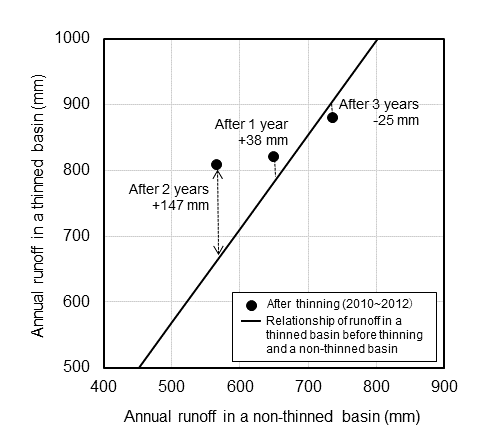Home > Research > Research Results > Research Results 2018 > To clarify the influence of tree thinning on the runoff amount from a forest on a catchment scale
Main content starts here.
To clarify the influence of tree thinning on the runoff amount from a forest on a catchment scale
| Article title |
Effects of thinning on canopy interception loss, evapotranspiration, and runoff in a small headwater Chamaecyparis obtusa catchment in Hitachi Ohta Experimental Watershed in Japan |
|---|---|
| Author (affiliation) |
Tayoko Kubota (a), Yoshio Tsuboyama (a), Tatsuhiko Nobuhiro (b) (a) Research Planning and Coordination Department, FFPRI, Tsukuba Ibaraki, Japan. |
| Publication Journal |
Bulletin of the Forestry and Forest Products Research Institute, 17(1):63-73, March 2018, URL:http://www.ffpri.affrc.go.jp/pubs/bulletin/445/445toc-en.html |
| Content introduction |
Half of the artificial forests in Japan are reaching maturity, but thinning has not been sufficiently conducted. When forest thinning is not conducted, the trees become crowded and their growth declines. Further, there is a concern that the function of a forest to prevent collapse may decline and the forest will be more affected by wind and snow damage. For these reasons, the Forestry Agency promotes thinning. Conversely, there is a concern that the function of forests to promote headwater conservation would decline if the area is subjected to thinning. To date, in Japan, the impact of forest thinning on headwater conservation function has been examined by measuring the changes in the net rainfall on a forest-plot scale with almost no studies conducted on a basin scale. Therefore, thinning (50% in number, 30% in volume) was conducted intensely in a small catchment area (0.82 ha) of a 23-year-old cypress (Chamaecyparis obtusa) forest. Then, we examined how the net rainfall and evapotranspiration changed and how the runoff changed compared with a basin where thinning has not been conducted. The thinning was conducted so that the soil surface is not disturbed, and the thinned trees were cut down and left on-site. With thinning, the annual runoff increased by 38 mm one year after thinning and 147 mm two years after thinning; it then returned to the pre-thinning level after three years. The ratio of net rainfall in the forest to total rainfall increased from 80% to 82% prior to thinning. The small runoff increment was because the number of trees was reduced to half; therefore, throughfall increased but stemflow decreased. The annual mean evapotranspiration three years after thinning decreased by 140 mm and especially evapotranspiration in the summer declined greatly. Thinning is considered to increase the transpiration per tree. However, as the number of trees decreased, so did the transpiration volume in the basin overall, probably leading to an increase in runoff. In this way, it is assumed that thinning increases the headwater conservation function by suppressing evapotranspiration and increasing the runoff amount in the short term.
Figure. This figure shows the effect of increased runoff by thinning.
|
Copyright © Forest Research and Management Organization. All rights reserved.

